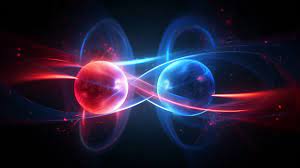They are particles in a quantum field, a wave, an excitation—a form of electromagnetic radiation. Photons are like little paint brushes, each carrying their own hue on a palette of colors. When they encounter obstacles, like land, trees, oceans, etc., some of them are absorbed and some of them are reflected to our eyes as light. Without them, we would be swallowed in a sea of darkness. They travel 93 million miles from our sun to make our forests green, our sunsets golden, our oceans blue—and to paint rainbows in the sky. A rainbow is one of the most mysterious and ephemeral phenomena in nature. The Greeks believed rainbows to be messages from the gods. When they appear, rainbows mesmerize. They create awe and wonder. The heavens painting with light. . .behold the rainbow!
Everyone has a favorite rainbow memory, an intimate experience with no one else around. Mine occurred looking out across a great caldera in New Mexico. With a jagged mountain range in the foreground, storm clouds opened, and the light poured down in shafts. In the distance veils and rags of rain hung down from the clouds, rain that falls and never hits the ground. Like a ghost a rainbow suddenly appeared against the hulking mountains, subtle and shockingly beautiful. Seldom in an ordinary lifetime do we get to experience such an intense event—the pure and sacred essence of things, man, and nature.
Being outside our control, rainbows can appear almost anywhere and anytime—even in the middle of the night! With an astonishing playbook, how they appear depends on our point of view (talk about a metaphor for life!). With one end anchored in a golden spot of sun and the other in the eye of the beholder, they can be single, multiple, full arcs, circles, or part circles. But are they real? Can you look down from the clouds and still see them? Can you touch them? Science can sometimes destroy the beauty of nature when stripping away its mystery. It’s the risk we run to better understand how something works. I love rainbows. Let’s just hope when this is finished, it’s not a permanent mark. If you already know or really don’t care how a rainbow works, skip to the last two paragraphs.
All rainbows are optical illusions. . .tricks that the eyes play on the mind. A rainbow does not actually exist at a specific spot; it depends on where the source of light is vs. your point of observation. The light source usually needs to be behind the viewer, such as the sun at your back. Rainbows are actually full circles, but since you can’t see below the ground, you only see the top half. Light radiates out from the sun (or other light source) to the center of the arc of the rainbow. If viewed from aircraft, passengers can sometimes see these full circles. No one sees the same rainbow—each person has a different vantage point, a different horizon. Someone who appears below or near the “end” of a rainbow will see a different rainbow, extending from that different horizon.
A rainbow shows up as a spectrum of light which appears in this order: red, orange, yellow, green, blue, and violet. It does this because sunlight (white light) strikes water droplets suspended in the atmosphere at just the right angle. These droplets act as little prisms—light enters white and leaves as a rainbow. This happens by separating white light into its different wavelengths (after multiple rounds of refraction/reflection) and reflecting them back into our field of vision. This means any atmosphere containing water droplets exposed to a light source can produce a rainbow (you can make one by spraying a garden hose before the sun). Some scientists think rainbows also exist on Titan, one of the moons of the planet Saturn. Titan has a wet surface and humid clouds. The sun is also visible from Titan, so it has all the ingredients for rainbows.
Angles are important aspects of rainbows. The higher raindrops in the sky disperse light in such a way that only the red-light travels to the observer’s eyes. All raindrops at this higher-level bounce red light to our eyes. The remaining colors exit at a lower angle. Raindrops successively lower in the horizon therefore bounce different colors of light, so, when all levels are taken together, the observer sees a full color spectrum. Again, all the raindrops making the same angle to the observer bounce light the same way.
Let’s take a closer look at some of the different kinds of rainbows:
Double Rainbow. A faint secondary rainbow appears above the primary one. These are caused by light being reflected twice within the raindrops which reverses the spectrum of light. Red is on the inner section of the arch, while violet is on the outside. It’s all about angles.
Twinned Rainbow. A twinned rainbow is two distinct rainbows produced from a single endpoint. Twinned rainbows are the result of light hitting an air mass with different sizes and shapes of water droplets—usually a raincloud containing varying types of raindrops.
Higher order rainbows. Light can be reflected from many angles inside the raindrop, producing different intensities. A rainbow’s “order” is its reflective number. (Primary rainbows are first-order rainbows, while secondary rainbows are second-order rainbows, etc.) Higher-order rainbows appear to viewers facing both toward and away from the sun. Higher-order rainbows are named by their reflective number, or order. In the lab, scientists have detected a 200th-order rainbow.
Reflection rainbow. A reflection rainbow appears above a body of water. A primary rainbow is reflected by the water, and the reflected light produces a reflection rainbow. Reflection rainbows do not mirror the primary rainbow—they often appear to stretch above it.
Red rainbow. A red rainbow, also called a monochrome rainbow, usually appears at sunrise or sunset. During this time, sunlight travels further in the atmosphere, and shorter wavelengths (blue and violet) have been scattered. Only the long-wavelength red colors are visible in this rainbow.
Fogbow. This rainbow is formed on water droplets in the fog. Because fog droplets are much smaller than raindrops, fogbows have much fainter colors (lower order) than primary order rainbows. In fact, some fogbows have few detectable colors at all and appear mostly white, with a reddish tinge on their outer edge and a bluish tinge on their inner edge.
Moonbow. This may be the most eerie of all rainbows, appearing with a fat summer moon shining white and pure overhead at night. Also called a lunar rainbow, they’re formed by reflected light shining against a water source, like the misty spray of a waterfall. Because moonlight is so much fainter than sunlight, moonbows are also dimmer than primary rainbows.
Rainbows make up the myths of many cultures around the world. Probably because rainbows are pleasant to experience, they are usually seen as positive symbols. In the Epic of Gilgamesh and, later, the Christian Bible, the rainbow is a symbol from a deity (the goddess Ishtar and the Hebrew God) to never again destroy Earth with floods. Sometimes, however, rainbows are negative symbols. In parts of Burma, for instance, rainbows are considered demons that threaten children. Tribes throughout the Amazon Basin associate rainbows with disease. Then there are the fun myths, like the Irish legend of the pot of gold at the end of a rainbow. The gold is guarded by a tricky leprechaun, but—because no one sees the same rainbow and rainbows don’t “end” (they’re circles)—no one ever finds the gold or the magical creature. Just another version of unrequited desire.
In effect, rainbows are painted with light, and the results are beautiful and mysterious, but there’s more to rainbows than meets the eye. Our ability to perceive the world through our senses may be more limited than we know. While the theory of relativity is thought to adequately describe phenomena in the universe on a grand scale (like planets and galaxies), quantum theory suggests subatomic phenomena may not always support the idea that “seeing is believing.” What follows is truly bizarre.
Quantum mechanics describes how very small particles (like photons, electrons, etc.) work. We think we understand the optical illusion of rainbows. But do we? There is a very nonsensical effect of quantum mechanics known as quantum entanglement which sees each small particle in nature having a perfectly coordinated counterpart (sometimes extremely far away—like light years!) which acts or reacts in exact replication of its counterpart in any given situation—with no apparent connection between the two. The implication is that what we see is not real, e.g., quantum entanglement violates Einstein’s concept of “space.” This means particles under quantum entanglement are not single entities but rather a “fog” or “smoke” or “cloud” which has no reality until it is observed by an organism. Hmmm. If there are simultaneous rainbows on Titan, who or what is observing them?
By Larry Gfeller













